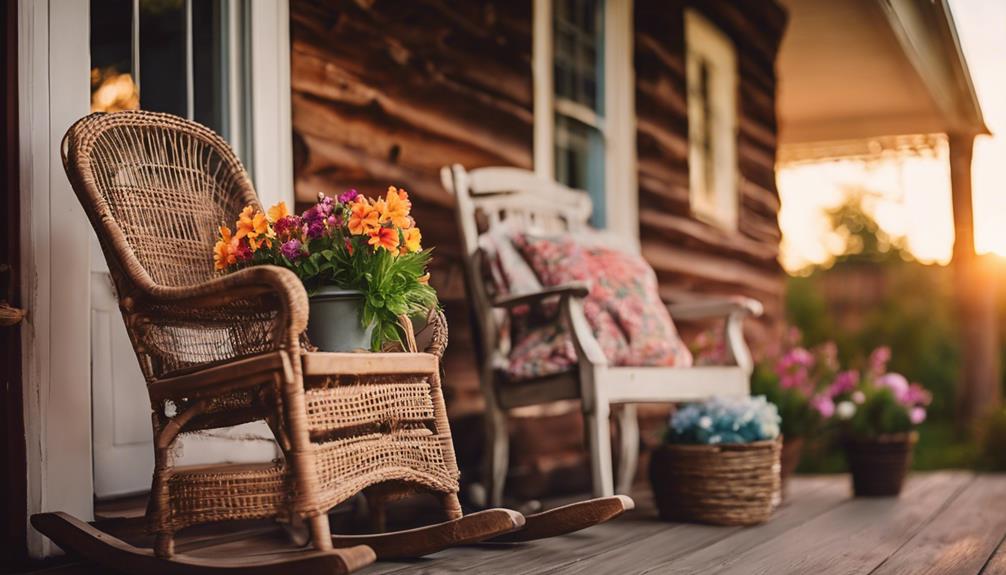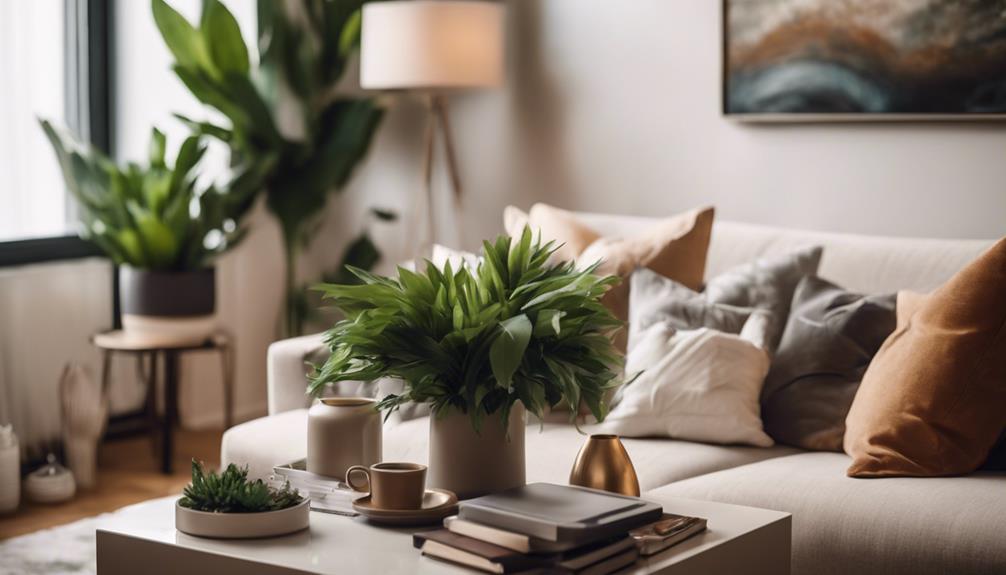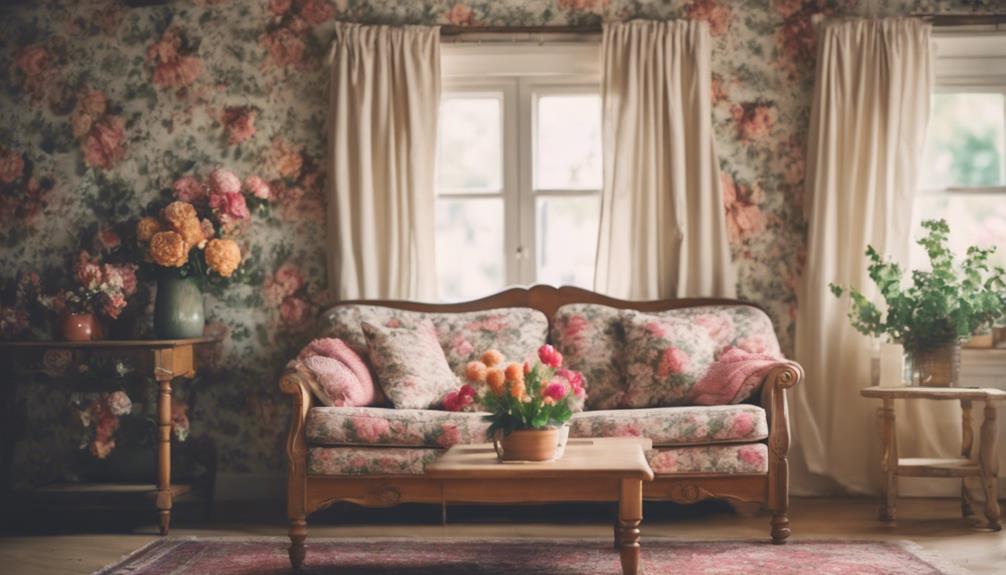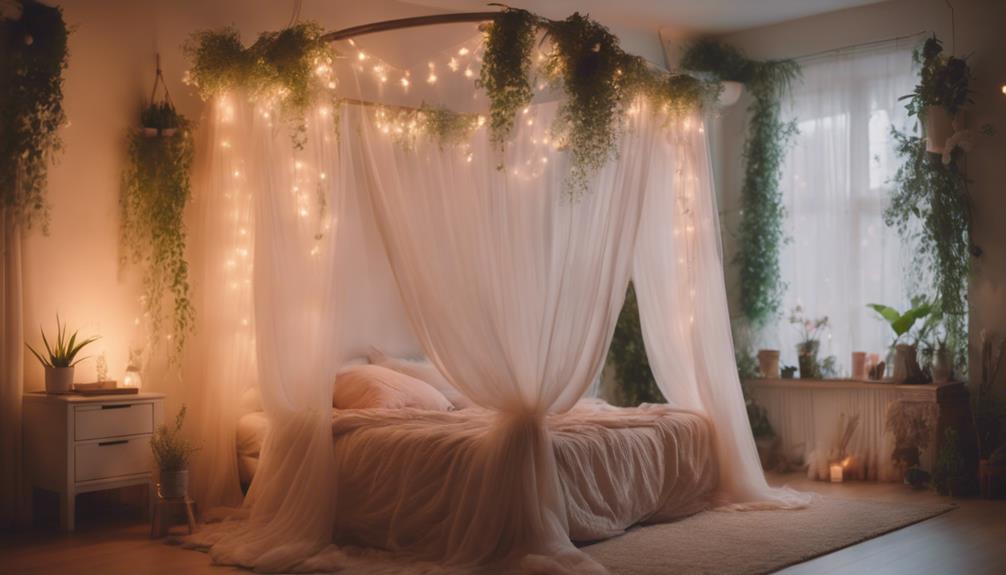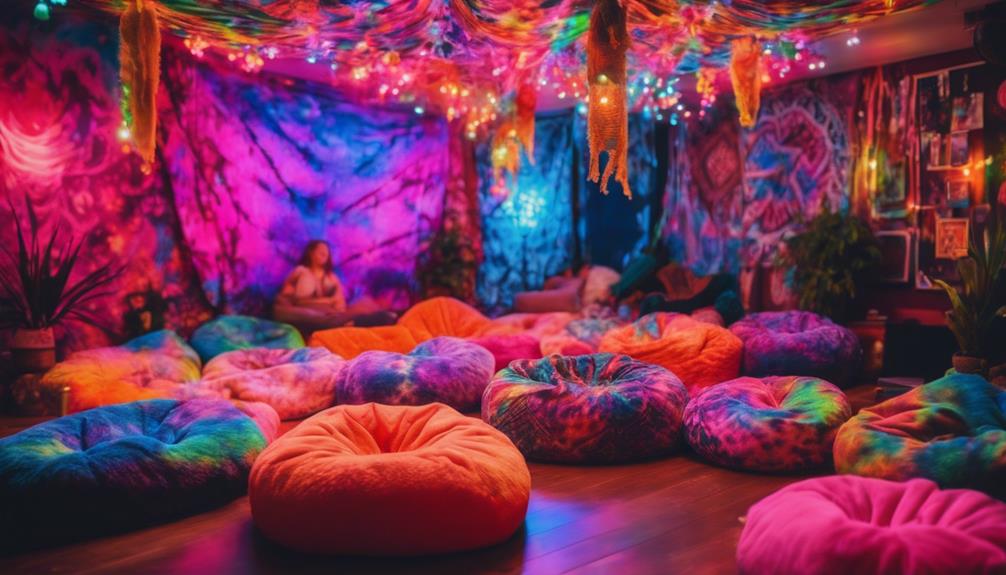When choosing between wicker and wood for your country porch, consider both style and maintenance. Wicker is lightweight, weather-resistant, and low-maintenance, making it perfect for easy rearrangements and seasonal updates. It comes in various colors and patterns, adding a versatile touch. On the other hand, wood offers a classic, warm aesthetic that blends beautifully with nature but requires regular upkeep. Think about your personal style and what fits your space best. Each option has its charm and practicality, so exploring more details can help you decide what's right for your porch sanctuary.
Key Elements
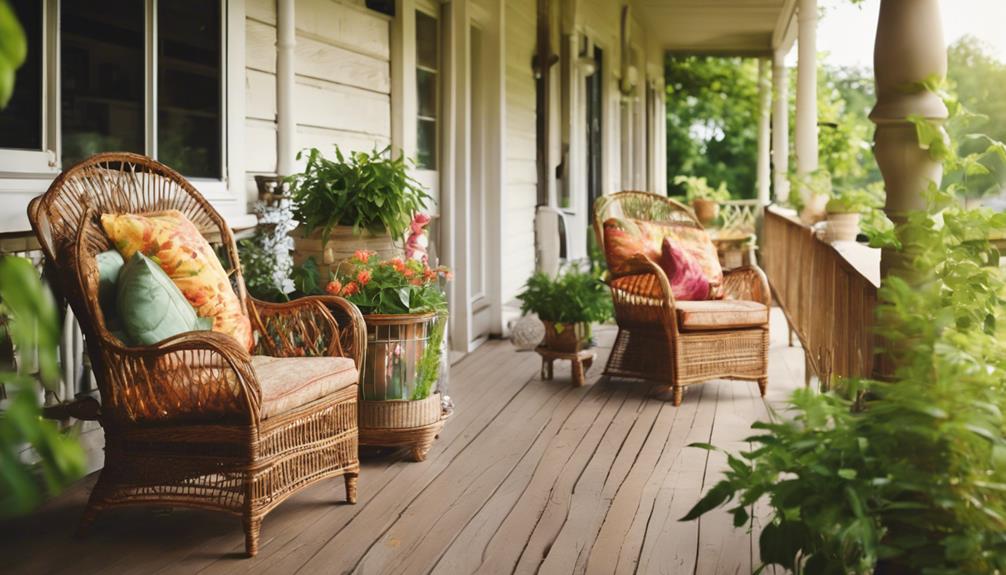
When you're picking out furniture for your porch, consider the color scheme, materials, and textures that best fit your style.
Wicker and wood offer different aesthetics, so think about how each option complements your home.
Balancing these key elements will help you create a cohesive and inviting outdoor space.
Color Scheme
Selecting the right color scheme for your porch involves considering the natural palette of your surroundings and how wicker or wood furniture can enhance that aesthetic.
When you think about color options, wooden furniture typically offers warm tones that blend seamlessly with the landscape, creating a cozy atmosphere. Popular wood types like teak and cedar provide rich hues that add sophistication to your porch.
On the other hand, wicker furniture brings versatility to your design. It comes in various colors and patterns, allowing you to match or contrast with your decor. Neutral shades like beige, brown, and white can enhance a rustic vibe, while vibrant cushions or throws can liven up a wicker patio, adding a splash of color that complements earthy tones.
If you choose wood, remember that the stain you select can considerably impact your color scheme. A natural finish highlights the grain, while darker stains lend a modern look.
Also, consider seasonal changes; wicker's synthetic options resist fading, making them a practical choice for consistent color retention, while wood may need treatments to maintain its original hue.
Choose wisely, and your porch will reflect your personal style beautifully.
Materials
Choosing the right material for your porch furniture is essential, as it influences both the aesthetic and practical aspects of your outdoor space. Wicker and wood each offer distinct advantages for your outdoor furniture pieces.
Wicker, often made from synthetic resin or natural rattan, is lightweight and weather-resistant, making it a practical choice for various climates. Plus, it requires minimal maintenance—just a simple cleaning will do!
On the other hand, wood, crafted from durable types like teak, cedar, or eucalyptus, provides a classic, timeless look that enhances your country porch's natural ambiance. However, it necessitates regular sealing or staining to prevent rot and weather damage, which can be a hassle.
While wicker may initially be more budget-friendly, remember that its lower long-term maintenance costs can make it an economical choice over time.
Ultimately, if you value versatility in color and design, wicker is likely your best bet. But if you prefer a warm, traditional feel, wood could be the way to go.
Consider your lifestyle and how much upkeep you're willing to manage when making your decision.
Textures
Textures play an essential role in defining the atmosphere of your porch, influencing both comfort and style.
When you consider wicker furniture, you'll notice it offers a variety of textures thanks to its woven design. Smooth rattan or synthetic resin options can create a casual and inviting feel that's perfect for relaxation. Plus, the tactile experience of wicker can enhance comfort, especially when combined with plush cushions that make rearranging easy.
On the other hand, wood furniture showcases the natural grain and texture unique to each type of wood. For instance, teak brings a smooth finish, while cedar offers a more rustic texture. You can also enhance wood textures through treatments like sanding or sealing, which highlight the wood grain's beauty and provide a polished look.
Ultimately, your choice between wicker and wood will influence your porch's ambiance. Wicker furniture leans toward a relaxed vibe, while wood furniture offers a classic, timeless aesthetic. By carefully considering the textures of each option, you can create a welcoming space that reflects your personal style and enhances your outdoor living experience.
Essential Fixtures and Furniture
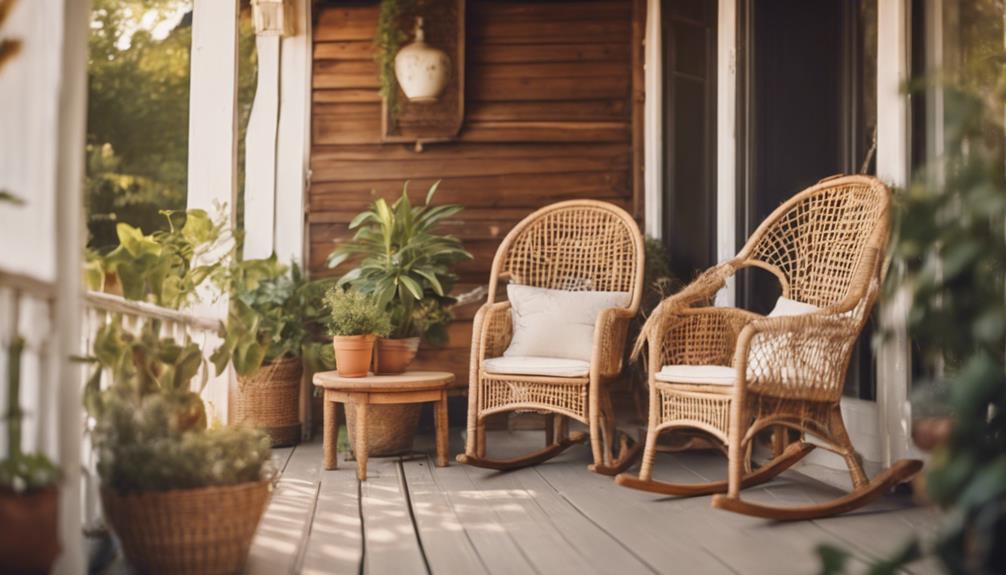
When setting up your porch, think about adding a rocking chair set for that classic touch or a hammock swing chair for ultimate relaxation.
An outdoor wicker coffee table can serve as a stylish centerpiece while providing a place for drinks and snacks.
Choosing fixtures that match your style will create a welcoming atmosphere for everyone.
Rocking Chair Set
A rocking chair set transforms your porch into a cozy retreat, blending comfort and style effortlessly.
When choosing between wicker outdoor furniture and wood patio furniture, consider your preferences for maintenance and aesthetics. Wicker rocking chairs offer a lightweight, comfortable option that allows for easy rearrangement, creating a casual and inviting vibe. Plus, their weather resistance means they can withstand various outdoor conditions with minimal upkeep.
On the other hand, wooden rocking chairs, especially those crafted from durable materials like teak or cedar, provide a timeless look that enhances the classic appeal of your outdoor space. However, they may require regular sealing or staining to protect them against the elements, ensuring longevity and maintaining their beauty over time.
Both options can be personalized with cushions or throw pillows, adding to your comfort while enhancing your porch's style.
Ultimately, whether you opt for wicker or wood, a rocking chair set will elevate your outdoor experience, making it a perfect spot for relaxation or conversation with family and friends.
Choose what best fits your lifestyle and enjoy your country porch to the fullest!
Hammock Swing Chair
If you're looking to add a unique touch to your porch, a hammock swing chair offers a cozy and relaxing seating option that complements your outdoor space beautifully.
This piece of furniture provides a gentle swaying motion, perfect for unwinding after a long day. Made from durable materials like weather-resistant wicker or sturdy wood, these chairs can withstand the elements while enhancing your porch's aesthetic.
Many hammock swing chairs come with cushions or padding, ensuring comfort during leisurely afternoons spent outdoors. You can easily find one that fits your style, as various designs and colors are available, allowing you to match it seamlessly with your existing wooden patio furniture.
Installing a hammock swing chair is typically straightforward. You'll often need just a sturdy support beam or frame, making setup and removal a breeze.
Whether you prefer the natural look of wood or the charm of wicker, a hammock swing chair can elevate your country porch experience. So, consider adding this essential fixture to create a cozy nook where you can relax and enjoy the beauty of your outdoor space.
Outdoor Wicker Coffee Table
Transform your outdoor space with an outdoor wicker coffee table that combines style and functionality while enhancing your porch's inviting atmosphere.
Made from durable synthetic materials, these tables resist fading and weather-related damage, making them perfect for any climate. Their lightweight design allows you to easily rearrange your setup, adapting to your needs for gatherings or relaxation.
You'll love the variety of colors and styles available, which means you can customize the look to match your existing outdoor decor seamlessly. Plus, many outdoor wicker coffee tables come with glass tops or added storage options, boosting their practicality without sacrificing aesthetic appeal.
When it comes to maintenance, you'll find it incredibly simple. Just clean your wicker table occasionally with a mild detergent and water, and it'll look fresh year-round. This ease of upkeep makes outdoor wicker coffee tables a smart choice for busy lifestyles.
Lighting Ideas

When it comes to lighting your porch, you've got some fantastic options to enhance both style and functionality.
String lights can create a warm atmosphere, while lanterns and solar-powered garden lights add a charming touch.
Don't forget about recessed LED ceiling lights for a sleek look that keeps your space well-lit and safe.
String Lights Along Railing
String lights along the railing create a warm, inviting atmosphere that enhances your country porch's charm, perfect for evening gatherings. To make your patio feel cozier, opt for weather-resistant string lights, ensuring they withstand the elements while maintaining their brilliant glow. These durable lights won't fade or deteriorate, allowing you to enjoy their ambiance season after season.
When installing your string lights, secure them with clips or hooks to keep them in place and protect your railing from damage. This not only enhances safety but also gives your porch a polished look. Consider using energy-efficient LED string lights, which consume less power than traditional incandescent bulbs, helping you save on electricity bills.
Don't hesitate to experiment with different styles and colors of string lights to match your porch decor. Whether you prefer a classic white glow or vibrant hues, the right choice can create a cozy atmosphere for relaxing evenings or lively gatherings with friends.
With thoughtful placement and selection, your country porch will become a stunning outdoor retreat that beckons you to enjoy every moment.
Lanterns on the Porch Steps
Lanterns on your porch steps can create a warm and inviting glow, guiding guests while enhancing the overall charm of your outdoor space. When choosing lanterns, consider using durable materials like powder-coated aluminum or synthetic wicker. These options are weather-resistant, ensuring your lanterns withstand the elements while maintaining their beauty.
Incorporating lanterns of varying heights and styles can add visual interest to your porch steps, complementing your design aesthetic. You might also want to hang lanterns from hooks or railings, creating a cozy illuminated pathway that invites relaxation and social gatherings.
For an eco-friendly twist, think about solar-powered lanterns that charge during the day, providing soft light without the need for electrical wiring. This not only saves energy but also enhances your outdoor ambiance with minimal effort.
No matter which style you choose, strategic placement of these lanterns will enhance your country porch's charm. By combining functionality and aesthetics, your porch steps will transform into a beautifully lit space, perfect for enjoying those warm summer evenings with family and friends.
Solar-Powered Garden Lanterns
Solar-powered garden lanterns offer an eco-friendly lighting solution that not only brightens your outdoor space but also enhances its aesthetic appeal. By harnessing sunlight during the day, these lanterns convert it into energy to provide illumination at night, reducing your energy costs. Many of these lanterns feature LED bulbs, which are energy-efficient and can last up to 25,000 hours.
When choosing solar lanterns, consider their brightness levels, which typically range from 10 to 100 lumens. Larger models are designed to illuminate wider areas, making them perfect for pathways or gathering spots on your porch. Additionally, most solar lanterns are crafted from weather-resistant materials like plastic or metal, guaranteeing they can withstand harsh weather conditions. They often include water-resistant seals to protect the internal components from rain.
To maximize the performance of your solar-powered garden lanterns, place them in areas that receive at least six hours of direct sunlight each day. This guarantees peak battery charging and reliable lighting throughout the night. With these lanterns, you'll not only create a warm atmosphere but also contribute to a sustainable lifestyle.
Recessed LED Ceiling Lights
While enhancing your outdoor space with solar-powered garden lanterns adds charm, consider how recessed LED ceiling lights can transform the ambiance indoors by providing sleek, modern illumination.
These lights blend seamlessly into your ceiling, creating a clean look without visible fixtures, which can elevate the overall aesthetic of your space.
Recessed LED lights are energy-efficient, using up to 75% less energy than traditional bulbs, which means lower electricity bills for you. Plus, with lifespans ranging from 25,000 to 50,000 hours, you won't need to worry about frequent replacements.
They come in various color temperatures, allowing you to customize the atmosphere to match your furniture and decor made of natural materials.
These lights also enhance the sense of space, making them perfect for smaller rooms or areas with low ceilings. You'll enjoy even lighting distribution that highlights your chosen furniture without being overwhelming.
Additionally, they're easy to maintain, ensuring your home stays stylish and functional. By choosing recessed LED ceiling lights, you'll create a welcoming and modern environment that perfectly complements your country porch aesthetic.
Decorative Elements

When it comes to adding decorative elements to your porch, consider incorporating vintage ceramic planters for a touch of charm.
Colorful outdoor throw pillows can instantly brighten up your seating, making it more inviting.
Additionally, a rustic wooden birdhouse can enhance the country aesthetic, bringing a sense of whimsy to the space.
Vintage Ceramic Planter
Vintage ceramic planters bring a timeless charm to your porch, showcasing vibrant colors and intricate designs that elevate your outdoor space.
These planters not only enhance aesthetics but also offer durability, as they're made from quality clay materials that withstand the elements. The excellent insulation they provide helps maintain ideal temperatures for your plants' roots, while their breathability supports healthy growth.
Many vintage ceramic planters come with drainage holes, which are essential for preventing waterlogging and root rot. This feature guarantees your plants thrive in a well-balanced environment, making your porch an inviting space for both flora and visitors.
Beyond their functional benefits, vintage ceramic planters serve as striking conversation pieces. Their unique patterns and glazes reflect your personal style and add character to your outdoor space. Plus, collecting vintage pieces can be a sustainable choice, as it repurposes older materials and encourages eco-friendly gardening practices.
Incorporating vintage ceramic planters into your country porch design not only beautifies the area but also fosters a connection to the past, creating a warm and inviting atmosphere that you and your guests will appreciate.
Colorful Outdoor Throw Pillows
Adding colorful outdoor throw pillows to your porch can instantly elevate the charm of wicker and wood furniture, bringing vibrant accents that enhance your outdoor experience. These pillows not only add a splash of color but also provide extra comfort for your seating areas, making them perfect for relaxation and social gatherings.
When selecting pillows, look for options made from weather-resistant materials like polyester. These fabrics resist fading and deterioration due to sun exposure, ensuring your investment lasts season after season. Plus, many outdoor throw pillows come with UV protection, so their colors stay bright and vibrant even after prolonged sunlight.
You can easily customize your porch to reflect your personal style by mixing and matching different patterns and colors. Whether you prefer bold prints or subtle hues, there's a throw pillow out there that complements your existing decor and seasonal themes.
Incorporating colorful outdoor throw pillows not only enriches the aesthetic appeal of your wicker and wood furniture but also transforms your outdoor space into an inviting haven. So go ahead, explore your options, and let your style shine through!
Rustic Wooden Birdhouse Decor
Rustic wooden birdhouses bring a touch of charm to your porch, seamlessly blending with the natural surroundings and creating a cozy atmosphere. By choosing these unique pieces, you not only enhance your outdoor decor but also embrace eco-friendly decor options. Utilizing untreated or reclaimed wood for your birdhouses contributes to sustainability while showcasing a beautiful weathered look that adds character to your space.
These rustic wooden birdhouses often feature hand-painted details and intricate carvings, which set them apart as functional art pieces. They invite local bird species to nest, fostering a delightful connection with nature right outside your door. Plus, you can easily incorporate colorful accents or seasonal decorations, transforming these birdhouses into focal points that grab attention.
When you position your birdhouses thoughtfully throughout your porch, you'll create an inviting environment that encourages lively interactions with wildlife.
Flooring
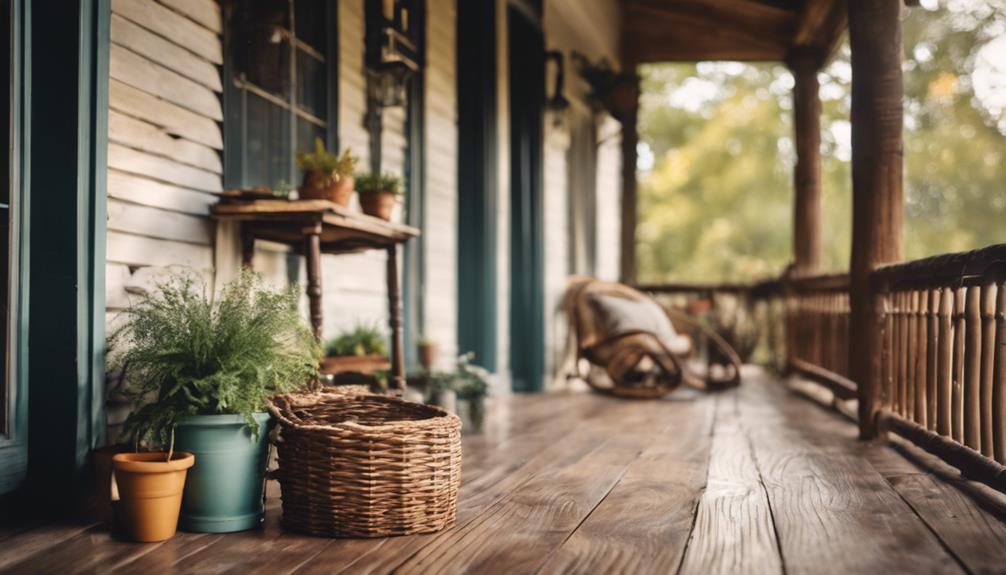
When it comes to flooring for your porch, you've got some great options to evaluate.
Reclaimed wood planks offer a rustic charm, while composite decking boards provide durability without the upkeep.
If you're looking for an elegant touch, natural stone pavers can elevate your outdoor space while being resilient against the elements.
Reclaimed Wood Planks
Reclaimed wood planks offer a unique and sustainable flooring option for your porch, showcasing rich character and history while reducing environmental impact. Sourced from old buildings and barns, these planks provide a distinct aesthetic that enhances the charm of your outdoor living space.
One of the standout features of reclaimed wood is its durability. The aging process naturally strengthens the wood, making it capable of withstanding the elements better than many new materials. When properly installed and maintained, reclaimed wood flooring can last for years, providing a visually appealing solution that adds warmth and character to your porch.
Additionally, reclaimed wood comes in various species, textures, and colors, allowing you to choose a style that perfectly complements your country porch. This diversity not only enhances the beauty of your outdoor area but also gives it a sense of history and authenticity.
Composite Decking Boards
Composite decking boards offer a modern, eco-friendly solution for porch flooring, combining the beauty of wood with the durability of plastic. Made from a blend of recycled wood fibers and plastic, these boards provide a sustainable alternative to traditional wood decking.
You'll appreciate their remarkable resistance to fading, staining, and mold, which means less maintenance for you compared to wood that often requires regular sealing and staining.
With warranties typically spanning 25 years or more, the durability of composite decking boards is impressive, ensuring they'll withstand the elements over time. You can choose from various colors and textures, allowing you to achieve the natural wood look you desire while enjoying enhanced weather resistance.
Safety is another significant advantage; unlike wood, composite decking doesn't splinter, making it a safer choice for families with children and pets. Plus, cleaning is a breeze—just soap and water will do the trick.
If you're seeking a long-lasting, low-maintenance option for your country porch, composite decking boards might just be the perfect fit for your lifestyle.
Natural Stone Pavers
If you're exploring flooring options for your porch, consider the timeless beauty and durability of natural stone pavers, which come in various types like granite, limestone, slate, and travertine. Each type offers unique aesthetics that can enhance your outdoor space while providing a durable surface that withstands the elements.
Natural stone pavers are highly weather-resistant, making them ideal for outdoor use. With proper care, many of these stones can last for decades, guaranteeing a long-term investment in your porch. Additionally, they provide excellent slip resistance, which is vital for safety, especially during wet conditions.
While you might be tempted to install natural stone pavers yourself, it's often best to seek professional help. Their weight and the need for precise fitting can make installation challenging, but this guarantees a stable and attractive surface for your porch.
One of the benefits of natural stone is its low maintenance. A routine cleaning with water and a mild detergent is usually all it takes to keep the surface looking pristine.
Conclusion
In the end, choosing between wicker and wood for your country porch comes down to your style and needs. When it comes to style, wicker offers a more relaxed and casual aesthetic, while wood can provide a more traditional and rustic look. Additionally, consider the maintenance and durability of each material to ensure it meets your needs for the long term. Keep in mind that outdoor furniture trends may also influence your decision, so do some research to see what is currently popular in country porch design. Ultimately, the choice between wicker and wood will depend on what best suits your personal style and how you plan to use your country porch.
Wicker offers a relaxed, airy vibe, while wood brings timeless strength and warmth.
Consider the essential fixtures, lighting, and decorative elements that complement your choice.
Whatever you decide, make sure your flooring ties everything together for a cozy, inviting space.
With the right combination, you'll create a porch that's perfect for enjoying those peaceful country moments.
